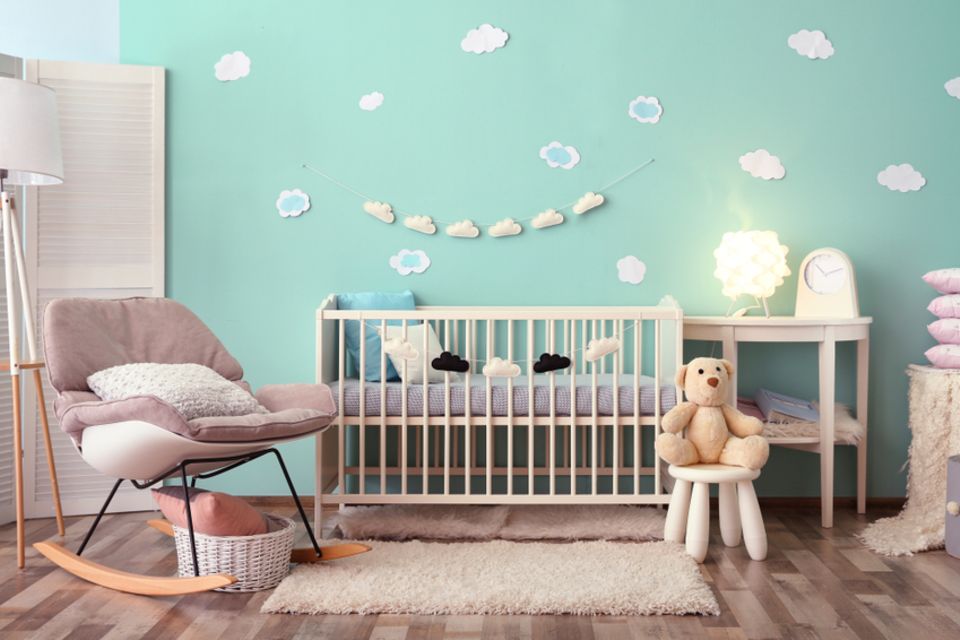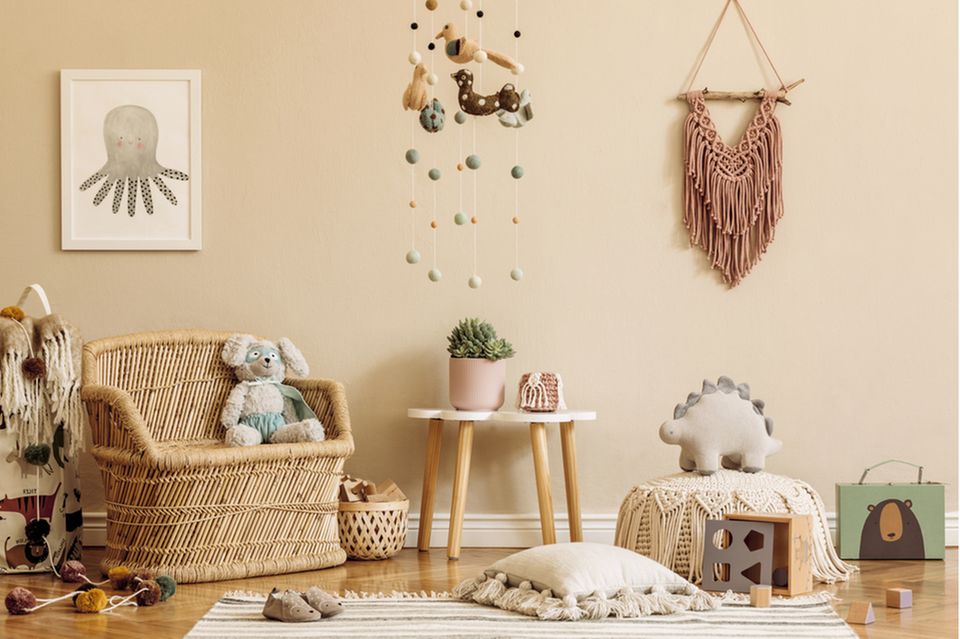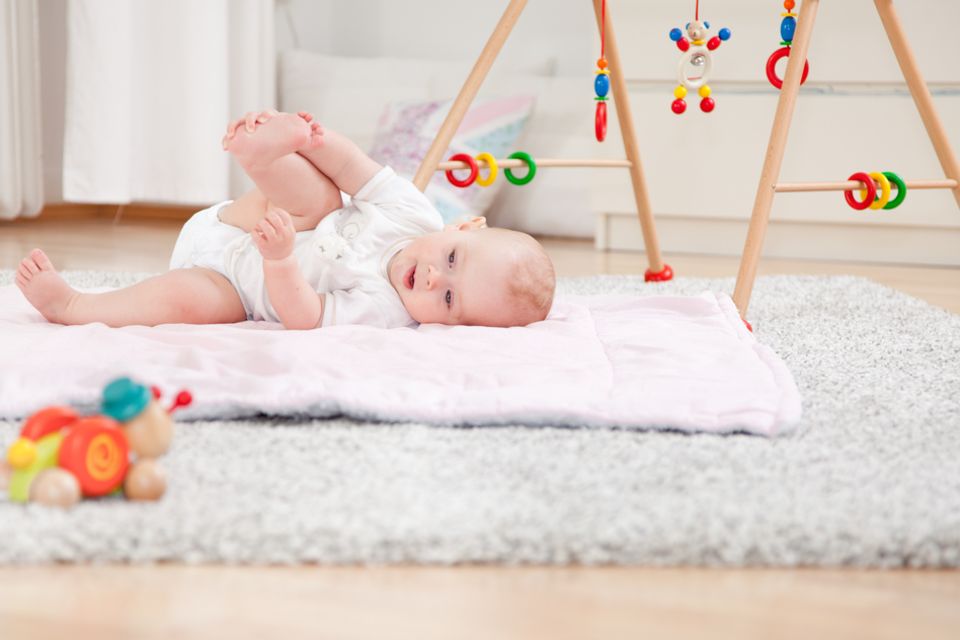A baby on the way? Great! We give you the best tips on how to set up a baby room for the new arrival. You can find out here what you really need and what you should pay attention to.
When a baby is on the way, the anticipation is great – and also the question marks (at least for the first child). What does the baby need? And what about the parents? There are now a lot of products for babies and children, but not all of them are necessary. Below we will show you what things can be useful for a baby’s room.
Setting up a baby room: an overview of the furnishings
- Bed frame and mattress
- Sleeping bag/blanket
- Changing table/changing attachment and changing mat
- Wardrobe with lots of baby clothes and utensils
- Child-friendly lamp and night light
- Seating plus blanket and pillow
- Curtains and carpet
- Wallpaper, wall paint and/or other wall decoration
- Playmat and selected toys
9 ideas for furnishing and designing the baby room
If you have a new baby, you will soon have to start planning a baby room. You can find out what you really need here. Plus further tips and inspiration for furnishing. You can find a summary list at the end of the article.
1. Baby bed for the offspring
Where the baby sleeps is an individual decision. Each family must decide for themselves whether a family bed is an option (you can find an overview of the advantages and disadvantages of a family bed here). If you don’t decide on a family bed, one is suitable, for example Extra bed for the first time with a newborn. This is practically docked to the parents’ bed in the bedroom. This means that the offspring are close by – which can be advantageous given the little ones’ lively appetites.
An alternative is the classic one Cot. For safety reasons, you should ensure that there are small gaps between the bars so that the child does not get caught in them. An adjustable slatted frame is advantageous, so you don’t have to bend down so low at the beginning, but you can lower the bed over time so that your little one doesn’t fall out as a toddler.
Tip: Furniture that grows with you can be practical and easy on the wallet because it is used over a longer period of time. The baby bed then becomes a children’s bed without bars and, if that has become too short, a children’s sofa!
2. Further equipment for the baby bed
A baby bed doesn’t need much. The mattress should be firm and breathable. The Federal Center for Health Education (BZgA) advises against using pillows as well as nests and sheepskins in baby beds in order to avoid overheating or congestion in breathing. Respiratory congestion occurs when the baby breathes in its own air again and therefore does not receive enough oxygen.
A blanket can also be problematic under certain circumstances as it can be pulled over the baby’s face. Therefore, it is recommended Sleeping bag. The correct size is calculated as follows: height of the baby – length of the baby’s head + ten to 15 centimeters, so that the offspring still has room to kick and grow. The neck circumference of the sleeping bag should not be larger than the baby’s head circumference. If you want to use a blanket, you should choose a flat model, tuck it under the mattress at the foot end and only cover the child up to the chest. Beforehand, put the baby in bed so that his feet touch the lower edge of the bed.
3. Matching changing table
If you’re not completely diaper-free, you’ll definitely need a changing table. Furniture for changing is available in different versions as a changing table, changing rack or wall changing rack as well as separately available changing attachments, e.g. B. for an existing chest of drawers. When choosing, pay attention to the size of the lying surface and do not choose it too small. On the one hand, the child still has enough space to kick around or move around and, on the other hand, part of the area can be used to store changing utensils, which are then within easy reach. The height of the changing table is also an important point, especially for you. Choose the height so that you can wrap in a relaxed position while standing upright. Place a changing mat on the changing mat, which is best washed.
Practical: Changing tables usually have several drawers, and sometimes open compartments for storage. Shelves also provide storage space for utensils and clothing. A changing attachment is useful if you already have a chest of drawers or a new one can be used later as soon as the child is dry.
4. More storage space with wardrobe
The number of baby clothes is often manageable at first. However, if you can’t make do with the space required by the changing table, you should think about purchasing a wardrobe. Over time, the equipment will certainly increase, so sooner or later one will be needed anyway. If you choose a children’s wardrobe, you will probably notice that they often have one or more rods for hanging clothes. Since this is usually not necessary for children’s clothing, especially for babies, you can make perfect use of the space with hanging storage. Towels, bed linen, care products and other things for the baby can also be stored in it.
5. The right lighting
You can create basic lighting with a ceiling lamp in the middle of the room. A plus point is a dimmable lamp, so that you can always adapt the lighting to the current situation, as the baby’s room has different lighting needs. It should be well lit for changing diapers, more discreet for breastfeeding or feeding and it should be possible to darken the room for the baby to sleep. A night light can help if you are afraid of the dark. Otherwise, a multi-part ceiling lamp that illuminates different areas is helpful, but also selective lighting, e.g. B. with wall lights or table lamps makes sense (e.g. for a nursing corner).
6. A corner to cuddle
If space permits, you can also set up a cozy corner in the baby’s room. This is ideal for breastfeeding or feeding, but also just for cuddling, reading to or singing to. A small sofa, a rocking chair or an armchair make the corner cozy and give you enough space for your cuddle time. A blanket and pillows should not be missing here.
You can find out here how you can later set up a child-friendly reading corner.
7. Textiles for comfort
As in all other rooms, the following applies in the baby room: Textiles make a room really cozy! Roller blinds or curtains help darken the room and bring a feel-good atmosphere into the room. In addition, carpets on the floor make it more comfortable.
8. Tips for wall design
At the beginning of their lives, babies’ vision is still blurred, but they can perceive different patterns and shapes as well as brightness. With increasing age, visual acuity continues to develop. Which wall design you choose is not relevant for your children at first, but wall paint etc. contribute to a beautiful ambience – and colors also have an effect on our mood!
Light colors create visual space and are particularly advantageous for small rooms, as dark colors can quickly appear overwhelming. Delicate and light colors such as light green or yellow as well as beige or pastel tones are ideal here.

© New Africa / Shutterstock
Either as an alternative or in addition to the wall color, wall objects such as: B. tapestries or pictures, a baby room more homely. If you like, you can also stick stickers or paint your own motifs on the walls. Or the classic way: choose a children’s wallpaper and wallpaper the room or a selected wall.
© Followtheflow / Shutterstock
9. Play corner for later © Toranico / Shutterstock
In the first few months a play area is not relevant, but in the foreseeable future your little worm will get bigger and get to know the world in a playful way. Here you can set up a corner to play in advance. How about a playmat on the floor, a play arch to explore and a few baskets to store toys?!
Safety in the baby room
Here you will find an overview of safety-relevant aspects in the baby room:
- Rounded corners/edges on furniture
- Tight bars on the bed
- Stable furniture that may be attached to the wall to prevent it from tipping over
- Safe materials for wall paint, furniture, textiles and toys
- Changing table/attachment with limit
- Keep electrical devices or other potentially dangerous items out of reach of the baby
- Child safety lock for sockets
As the offspring get older, their needs also change. Here you will find tips on how to get one You can design children’s rooms. Here you can find out what is important in a sibling’s room or a Montessori children’s room.
Sources used:
Federal Center for Health Education: Sleep recommendations for the 1st year of life


